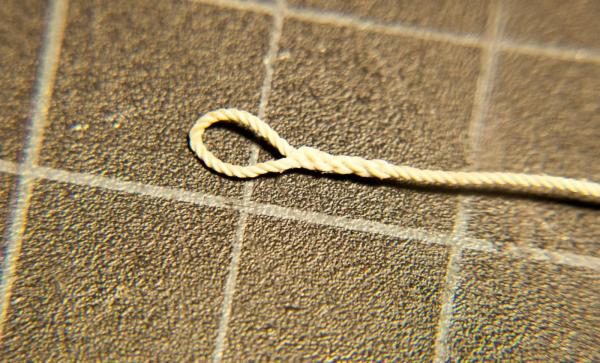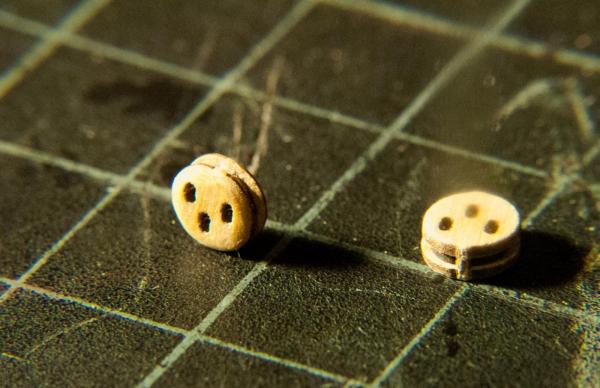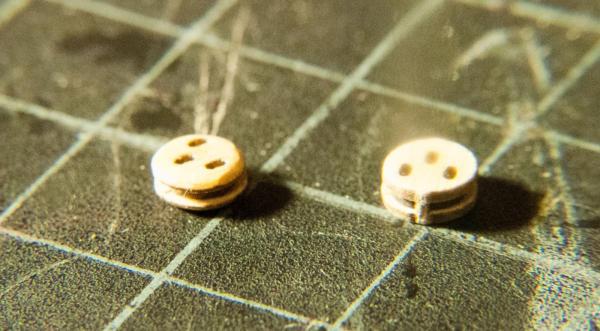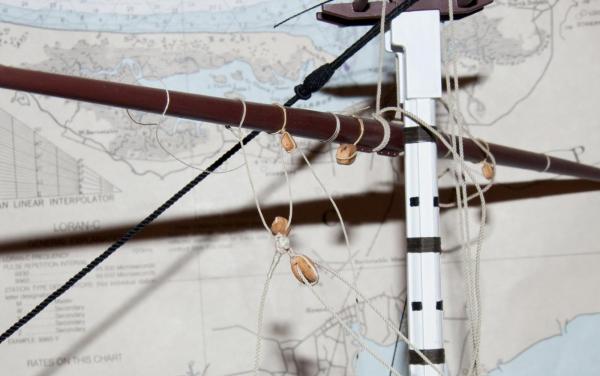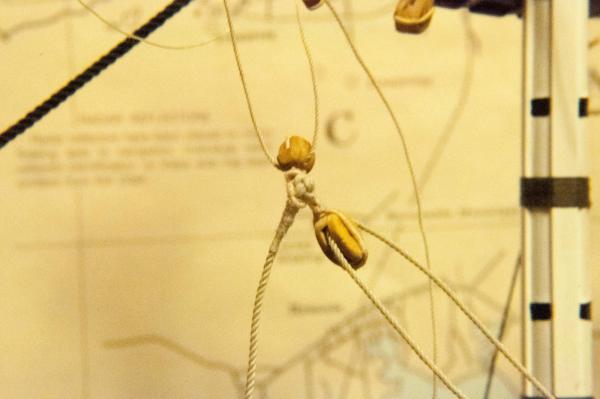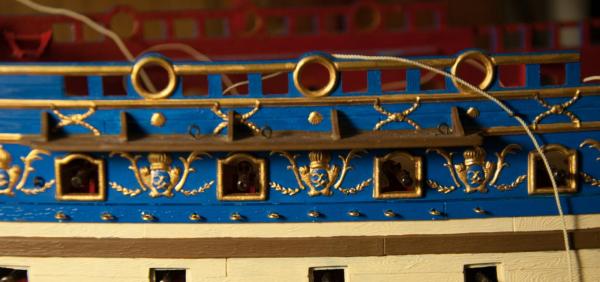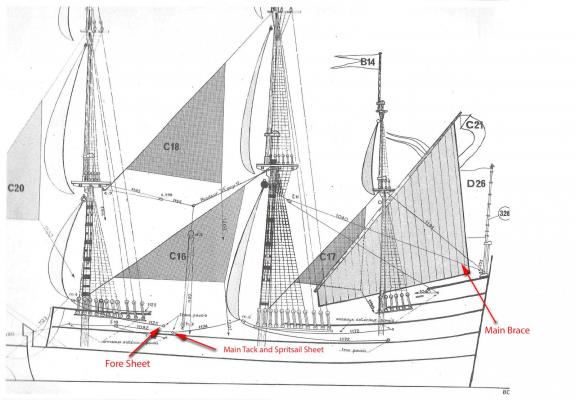-
Posts
1,935 -
Joined
-
Last visited
Content Type
Profiles
Forums
Gallery
Events
Everything posted by popeye2sea
-
Nice job on the thimble eye for the stay. Looking forward to watch how you raise the mouse. Regards,
-
Nice job on the crows feet. It's got to be a bear to get the tension right. Regards,
- 249 replies
-
- billing boats
- vasa
-
(and 1 more)
Tagged with:
-

Caldercraft Agamemnon riding bitts
popeye2sea replied to sharkscanner's topic in Wood ship model kits
I think it would make the most sense to have the riding bitts on the same deck level as the hawse ports. That is where the anchor cable would be. Regards, -
I think a wedge shaped piece will suffice for all. They pretty much share the same shape. Just remember to put the wider, untapered end towards the line. The sheave hole in the top and topgallant masts is for the top rope. It is what is used to hoist the mast into place. Once the mast is raised high enough a fid is inserted through the fid hole below the sheave. The fid extends beyond the mast on both sides. The mast is then lowered back down until the fid is resting on the trestle trees. That is what holds the mast up. Long winded answer I know, but it helps to know what the parts do so that you can represent them properly. That said, I believe that the sheave for the top rope goes right through the center of the mast. Otherwise the pull will be off center and the mast would not be hoisted straight up. You will probably find that there is an eyebolt under the mast cap on either side of of the mast. You will also notice that they are offset from each other. One is more forward than the other. One side takes the end of the top rope, the other takes a block for the top rope. If you follow the line from the eyebolt through the sheave in the topmast and back up to the block on the other side you will see that will pass through the topmast at an angle. Et voila, that is the angle that your sheave hole must pass through the topmast. The top rope sheave is set into the octagon portion in order to give the rope clearance to pass between the topmast and the trestle trees while the mast is being hoisted into position. Regards,
-
You will find them in lots of places. There may be several on the bowsprit for the gammoning and the fore stay. Possible also at the base of the main mast for the mizzen stay
-
Regarding line sizes. The same type of formula as for the deadeyes holds true for the rigging. Usually the main stay is the largest line on the ship and it will have a circumference equal to half the greatest diameter of the main mast. Or stated another way its diameter will be approx. 1/6 of the diameter of the main mast. All of the other rigging is a percentage of the main stay. Fore stay = 4/5 of the main stay Main shrouds and main topmast stay= 1/2 Fore shrouds, fore topmast stay, mizzen stay = 2/5 Main topmast and mizzen shrouds = 1/4 Fore topmast shrouds, fore and main topgallant stay, and mizzen topmast stay = 1/5 Shrouds of these last three = 1/6 More details for other parts of the rigging can be found in "The Rigging of Ships in the Age of the Spritsail Topsail 1600 - 1720", R.C. Anderson
-
Fine work on the mast pendants and shrouds, but Peter is right, the fiddle blocks should be seized in so that the larger block is above the smaller. Regards,
-
What you described is called a jam cleat. What year was your vessel built? Those are more of a modern fitting. Regards,
-
Are you referring to cleats that are used to keep a line from slipping down or along a spar? If so then depending on the location and the size of the line they are holding back they will have different sizes. I think in general they have a rectangular shape with a flat face against the line being held and the rear is tapered toward the spar. Perhaps a picture of what you are referring to will help to get the correct answer. Regards,
-
In order to figure out the proper lengths of the lines that will belay in the waist I need to temporarily set up some of the main rigging. So I stepped the main mast, crossed the main yard, and rigged the clew, sheet, tack and brace on one side. Let me just say that I love the challenges involved in rigging this ship as close as possible to the real vessel. But, it is obvious that it is going to add a looong time to the build. For example, all the blocks on the yard are stropped with long and short tails with eyes and rose lashed to the yard. The clew line is fastened to the yard with a timber hitch, and the brace pendant is put over the yardarm with an eye splice. The strops for the sheet and clew blocks were stropped with large eyes that have to be large enough to fit through each other and also admit the tack knot. Each individual block on the ship will have a different size or type of strop based on the blocks location, size, and purpose. All rigging will be fastened with proper seizings, lashings, bends, and hitches; no knots. As an example of the time I'm spending on these items. It took me about eight hours to perfect the tack knots before I could say that I like the result. Figuring out the lengths of the strops needed for the clew garnet and sheet blocks took a few trial and error attempts and about five hours to get right. Add to that the time it took to make the clew garnet block out of two 5mm Syren blocks and you get about 15 or 16 hours just on that one sheet tack and clew assembly. I really like the deadeyes that I purchased from Syren but I am taking them one step further. I am shaping them so that they have more of a bulge in the middle and go thinner towards the edge. Am I nuts? Maybe, but I really like the results. Here are some photos of the latest work. Iron strops for deadeyes next. Regards,
- 196 replies
-
- plastic
- soleil royal
-
(and 2 more)
Tagged with:
-
I look at it from another perspective. Weathering and making a ship look well used is an art and a skill that I do not yet possess. And I think that many do not. I look at models that are weathered and say to myself "I could never achieve that effect". Some may look at realistic models and be put off or discouraged by the level of skill displayed there. It is the same for any new endeavor one undertakes. Does that put me off from building? Not in the least. I work to my strengths and expand my knowledge along the way. To each his own. Regards,
-
The definition of a rigol is a gutter. So it does pretty much what it says; direct water away.
- 1,351 replies
-
- constitution
- model shipways
-
(and 1 more)
Tagged with:
-
BTW Tom, the "eyebrows" are called a rigol Regards
- 1,351 replies
-
- constitution
- model shipways
-
(and 1 more)
Tagged with:
-

Soldering dangerously close to the hull
popeye2sea replied to popeye2sea's topic in Metal Work, Soldering and Metal Fittings
I hear you Mark. I am going to try to do something else to get the soldering off the hull. See my latest thoughts in the build log. Regards, -
I think that no matter which way I go is going to involve a little surgery. So, here is my latest thought. Cut open the channels at the slots for the deadeyes so that the strops can then be slid in from the edge of the channel. Assemble and solder the chains and strops off the ship. Open the loops slightly on the eybolts in the wales; just enough to get the lower end of the chains on. Re-close the eyebolts. Slide the strops into the channels. Fill the gaps in the channels with styrene and then putty, sand and repaint the channels. Hopefully I won't make a mess of the eyebolts and the channels, but at least all of the soldering will be away from the hull. Regards,
- 196 replies
-
- plastic
- soleil royal
-
(and 2 more)
Tagged with:
-
Mast tackle pendants were used for more than just setting up the shrouds. They were also set up for lifting heavier items. For the lower masts they were usually in pairs, two on each side. They are the first to go over the mast. On the fore mast the aftermost pendant is a little longer than the other, and on the mainmast the forward pendant will be a little longer. The pendants thickness should be the same as the shrouds. At the ends of the pendants was fitted either a fiddle block or a double block. The pendant is secured through the strop of the block with a throat and a round seizing. The fiddle block will be on the shorter of the two pendants and the tackle will run in 4 parts to a single block with a hook. The double block will be on the other pendant and will run in 5 parts to a double block with a hook. Topmasts may have one pendant per side. Or they may have been omitted altogether. Hope that helps. Regards,
-

Soldering dangerously close to the hull
popeye2sea replied to popeye2sea's topic in Metal Work, Soldering and Metal Fittings
I think what I will do is cut the channels from the outside edge into the slots for the deadeyes so that I can swing the entire deadeye and chain assembly down away from the hull. That will give about 3/4 of an inch clearance from the hull to do the soldering. I'll put an alligator clamp heat sink on and slide something behind for a heat shield. Then I can swing the whole assembly back up into the slot and re close the opening in the channel with styrene. Regards, -
I need some assistance. Back when I started this build I basically just started following the kit instructions for assembling the hull and installed brass eyebolts where indicated on the upper wales. Since then I had learned that these eyebolts were Hellers version of anchor points for the chains. I have put off doing anything with them until now for several reasons, however it is now time to do something with them. The plans want you to tie line between the deadeye strops and the anchor points to simulate the chains. I do not wish to do this. My plan is to make the chains out of blackened steel wire. But here is the problem. I can not take those eyebolts out so my plan involves soldering the chains together while they are on the ship. I am very afraid of putting a soldering torch that close to the hull. Can anyone suggest a good material to use as a heat shield so that I do not scorch the paint work or melt the hull? Regards,
- 196 replies
-
- plastic
- soleil royal
-
(and 2 more)
Tagged with:
-

What thickness rigging cord do I need?
popeye2sea replied to Moxis's topic in Masting, rigging and sails
Although it is a little before the time period for the Clara May, David Steels The Art of Rigging gives a table of rigging dimensions for fore and aft rigged schooners of about 100 tons. It may be a good starting point in your research. -
The clew lines are the easiest and most straightforward to answer. The clew block, sheet block and tack block would all be hooked together (in practice the strops were actually passed through and around each other) and the clew block was hauled up almost to its leading block at the yard. The buntlines, leechlines, and bowlines would either be unrigged completely or the ends would be hitched around the yard. Probably at the locations where they would end up if the sail were furled.
-
The evolution of the eventual connection of the forecastle and quarter decks is tied directly to the evolution of the cannon. In the early days of fighting sail the ship was more like a floating castle full of infantry. Combat was mostly coming alongside, firing off volleys of arrows, the occasional shot from relatively weak cannons, and then boarding the enemy for hand to hand combat. Hence the need for towering fore castles and stern castles, just like on land, to give a height advantage and additional fire power. As cannons became more powerful and accurate, they came to be more the primary weapon. Take a look at the Sovereign of the Seas. Initially she had cannons mounted in her fore and stern castle pointing in every direction, even inboard towards the waist. That is because the fighting tactics had not caught up to the technology. They were still focused on closing and boarding more than gunnery. But she was also one of the first ships to be a true ship of the line. During her day line of battle tactics were developed and ships began to focus all of there fire power to the sides. In fact, during one of her later rebuilds all of the Sovereigns armament was shifted to fire outboard as broadside batteries. As the guns got bigger they needed to be carried lower in the ship. This obviated the need for the towering castles fore and aft and eventually they disappear altogether in favor of gun decks. The logical next step was even more cannons so the covering over of the waist provides more room for cannons. Regards,
- 66 replies
-
- resolution
- hunter
-
(and 2 more)
Tagged with:
-
To marl something is to make a series of half hitches over it. The purpose in this case is to hold the ends of the tapered strands down before serving over.
- 196 replies
-
- plastic
- soleil royal
-
(and 2 more)
Tagged with:
-
The madness continues... Working on getting the lower sail rigging set properly before the fo'c'sle is set into place. The lines involved are the main sheet, main tack, fore sheet, and sprit sail sheet. The basic idea I am following is to get the proper working length of line coiled on to the kevels so that the sail can be set or furled and the yards braced around as needed. So looking at the rigging plan uncovers some problems. The standing part of the main brace is made fast at the flag staff and the working end leads through a block on and eyebolt well aft then inboard over the rail to a belaying pin. Meanwhile an unused kevel is on the round house deck just forward of the poop deck (kevels are designed to carry heavier lines like braces). This lead is completely wrong. No brace would ever be fixed to the flag staff. My fix: The standing part of the brace will be seized to the eyebolt that formerly held its leading block. A new fairlead hole will be drilled through the side close by the un-used kevel on the round house deck and the main brace will belay on the kevel. The plan has the main tack and the sprit sail sheet leading through the same fairlead hole and belaying on the same kevel. There is not enough space in the fairlead or on the kevel for both lines. My fix: drill a new fairlead hole for the sprit sail sheet directly below the fairlead for the fore sheet. The sprit sail sheet will belay either on the same kevel as the fore sheet or on the kevel just forward of that. The only problem is (and this is probably the reason Heller did it that way) the forward kevel is well under the fo'c'sle deck and nearly inaccessible after the deck is placed. So I have to make the decision where to belay this line now. Not shown on the photo above: The fore tacks both lead through a single hole on the stem below the figurehead. I will drill an additional hole so that each tack has its own fairlead hole. While we are on the subject of the tack lines. For this ship the tacks run single and the end of the line was terminated in a tack knot which was put through the strops of the sheet and clew garnet blocks at the clew of the sail. The knot was actually a double wall and crown knot. Below is my attempt at the tack knots for the main sail. The knot is tied and set up so that the ends lead down through the knot then they are tapered, marled down, and served over. The line is 1.0 mm morope. Until next time... Laissez le bon temps rouler!
- 196 replies
-
- plastic
- soleil royal
-
(and 2 more)
Tagged with:
About us
Modelshipworld - Advancing Ship Modeling through Research
SSL Secured
Your security is important for us so this Website is SSL-Secured
NRG Mailing Address
Nautical Research Guild
237 South Lincoln Street
Westmont IL, 60559-1917
Model Ship World ® and the MSW logo are Registered Trademarks, and belong to the Nautical Research Guild (United States Patent and Trademark Office: No. 6,929,264 & No. 6,929,274, registered Dec. 20, 2022)
Helpful Links
About the NRG
If you enjoy building ship models that are historically accurate as well as beautiful, then The Nautical Research Guild (NRG) is just right for you.
The Guild is a non-profit educational organization whose mission is to “Advance Ship Modeling Through Research”. We provide support to our members in their efforts to raise the quality of their model ships.
The Nautical Research Guild has published our world-renowned quarterly magazine, The Nautical Research Journal, since 1955. The pages of the Journal are full of articles by accomplished ship modelers who show you how they create those exquisite details on their models, and by maritime historians who show you the correct details to build. The Journal is available in both print and digital editions. Go to the NRG web site (www.thenrg.org) to download a complimentary digital copy of the Journal. The NRG also publishes plan sets, books and compilations of back issues of the Journal and the former Ships in Scale and Model Ship Builder magazines.



